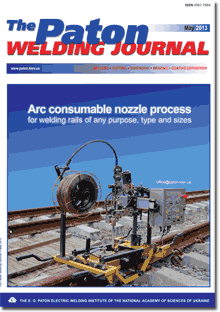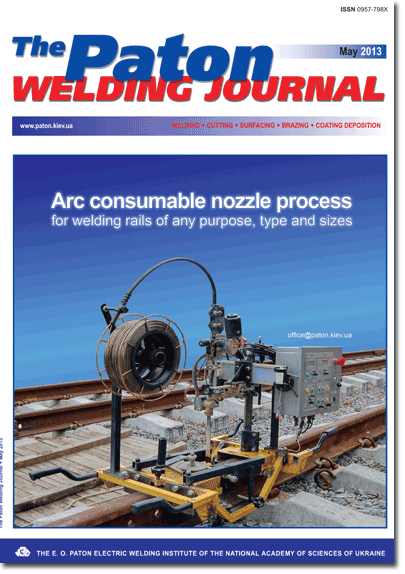| 2013 №05 (05) | 2013 №05 (07) |

The Paton Welding Journal, 2013, #5, 45-50 pages
INFLUENCE OF WELD POOL GEOMETRY ON STRUCTURE OF METAL OF WELDS ON HIGH-TEMPERATURE NICKEL ALLOY SINGLE CRYSTALS
K.A. YUSHCHENKO1, I.S. GAKH1, B.A. ZADERY1, A.V. ZVYAGINTSEVA1 and O.P. KARASEVSKAYA2
1E.O. Paton Electric Welding Institute, NASU, Kiev, Ukraine
2G.V. Kurdyumov Institute for Metal Physics, NASU, Kiev, Ukraine
Abstract
The main defect, which prevents realization of the advantages of high-temperature nickel alloy single crystals in production of welded assemblies and parts of gas-turbine engine, are stray grains in the weld metal. The objective of this work was studying the features of weld metal structure, depending on curvature of macrofront of weld pool solidification and determination of admissible deviations of the direction of maximum temperature gradient from orientation of predominant crystal growth. Experiments were performed with application of electron beam welding on single-crystal samples from commercial high-temperature nickel alloys JS26 and JS32, containing more than 60 % of strengthening γ`-phase. Welded joint structure was studied by optical metallography and X-ray diffractometry methods. It is shown that the main conditions for preservation of single-crystal structure in welding of high-temperature nickel alloy single crystals are correspondence of fusion plane to single crystal high-symmetry axes and coincidence of the direction of maximum heat removal over weld pool solidification front with <001> orientation of predominant crystal growth. Limit deviations for studied alloys and welding conditions are established. 15 Ref., 9 Figures.
Keywords: electron beam welding, single crystal, high-temperature nickel alloy, crystallographic orientation, weld, weld pool geometry, dislocation distribution, crystal growth direction, maximum heat removal direction, angle of deviation, stray grains
Received: 01.03.13
Published: 28.05.13
References
1. Shalin, R.E., Svetlov, I.L., Kachanov, E.B. et al. (1977) Single crystals of heat-resistant nickel alloys. Moscow: Mashinostroenie.
2. Kablov, E.N. (2001) Cast blades of gas-turbine engines. Alloys, technology, coatings. Moscow: MISIS.
3. Pollock, T.M., Murphy, W.Y. (1996) The breakdown of single-crystal solidification in high refractory nickel base alloys. Metall. and Mater. Transact. A, 27, 1081-1094.
4. Gakh, I.S. (2011) Physical-technological features of electron beam welding of heat-resistant high-nickel alloys with monocrystalline structure: Syn. of Thesis for Cand. of Techn. Sci. Degree. Kyiv.
5. Yushchenko, K.A., Zadery, B.A., Karasevskaya, O.P. et al. (2006) Structural changes during welding of nickel superalloy single-crystals in crystallographically asymmetrical location of weld pool. Metallofizika i Nov. Tekhnologii, 28(11), 1509-1527.
6. Yushchenko, K.A., Zadery, B.A., Zvyagintseva, A.V. et al. (2009) Peculiarities of the structure of metal deposited on edges of single-crystal blades made from nickel superalloys. The Paton Welding J., 8, 36-42.
7. Yushchenko, K.A., Zadery, B.A., Savchenko, V.S. et al. (2008) Welding and cladding of heat-resistant nickel alloys with single-crystal structure. Ibid., 11, 191-196.
8. Yushchenko, K.A., Zadery, B.A., Zvyagintseva, A.V. et al. (2009) About possibility of inheritance of single-crystal structure of complexly-doped nickel alloys in nonequilibrium conditions of fusion welding. Metallofizika i Nov. Tekhnologii, 31(4), 473-485.
9. Yushchenko, K.A., Zadery, B.A., Zvyagintseva, A.V. et al. (2008) Sensitivity to cracking and structural changes in EBW of single crystals of heat-resistant nickel alloys. The Paton Welding J., 2, 6-13.
10. Mughrabi, H. (1983) Dislocation wall and cell structures and long-range internal stresses in deformed metal crystals. Acta Metall., 31, 1367-1379.
11. Panin, V.E., Likhachev, V.A., Grinyaev, Yu.V. (1985) Structural levels of deformation of solids. Novosibirsk: Nauka.
12. Likhachev, V.A., Panin, V.E., Zasimchuk, E.E. (1989) Cooperative deformation processes and localization of deformation. Kiev: Naukova Dumka.
13. Malygin, G.A. (1995) Self-organisation of dislocations and localization of sliding in plastically deformed crystals. Fizika Tv. Tela, 37, Issue 1, 3-42.
14. Sarafanov, G.F. (1998) To theory of formation of inhomogeneous dislocation structures. Fizika Metallov i Metallovedenie, 85, Issue 3, 46-53.
15. Koneva, N.A., Kozlov, E.V. (1990) Physical nature of plastic deformation stages. Izvestiya Vuzov. Fizika, 2, 89-106.
Suggested Citation
K.A. YUSHCHENKO1, I.S. GAKH1, B.A. ZADERY1, A.V. ZVYAGINTSEVA1 and O.P. KARASEVSKAYA2 (2013) INFLUENCE OF WELD POOL GEOMETRY ON STRUCTURE OF METAL OF WELDS ON HIGH-TEMPERATURE NICKEL ALLOY SINGLE CRYSTALS. The Paton Welding J., 05, 45-50.The cost of subscription/purchase order journals or individual articles
| Journal/Currency | Annual Set | 1 issue printed |
1 issue |
one article |
| TPWJ/USD | 384 $ | 32 $ | 26 $ | 13 $ |
| TPWJ/EUR | 348 € | 29 € | 24 € | 12 € |
| TPWJ/UAH | 7200 UAH | 600 UAH | 600 UAH | 280 UAH |
| AS/UAH | 1800 UAH | 300 UAH | 300 UAH | 150 UAH |
| AS/USD | 192 $ | 32 $ | 26 $ | 13 $ |
| AS/EUR | 180 € | 30 € | 25 € | 12 € |
| SEM/UAH | 1200 UAH | 300 UAH | 300 UAH | 150 UAH |
| SEM/USD | 128 $ | 32 $ | 26 $ | 13 $ |
| SEM/EUR | 120 € | 30 € | 25 € | 12 € |
| TDNK/UAH | 1200 UAH | 300 UAH | 300 UAH | 150 UAH |
| TDNK/USD | 128 $ | 32 $ | 26 $ | 13 $ |
| TDNK/EUR | 120 € | 30 € | 25 € | 15 € |
AS = «Automatic Welding» - 6 issues per year;
TPWJ = «PATON WELDING JOURNAL» - 12 issues per year;
SEM = «Electrometallurgy Today» - 4 issues per year;
TDNK = «Technical Diagnostics and Non-Destructive Testing» - 4 issues per year.


